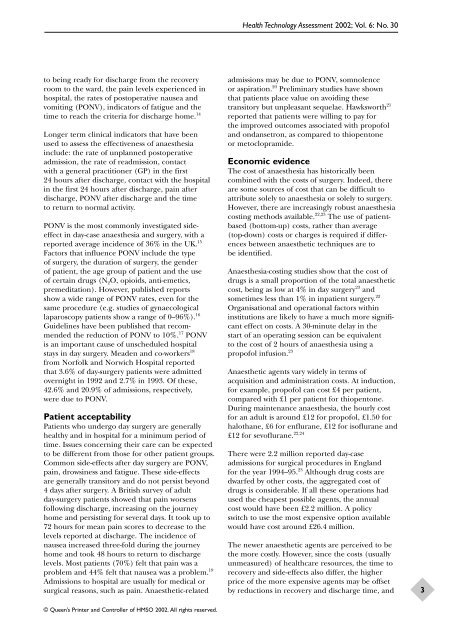Aanesthetic Agents for Day Surgery - NIHR Health Technology ...
Aanesthetic Agents for Day Surgery - NIHR Health Technology ...
Aanesthetic Agents for Day Surgery - NIHR Health Technology ...
You also want an ePaper? Increase the reach of your titles
YUMPU automatically turns print PDFs into web optimized ePapers that Google loves.
to being ready <strong>for</strong> discharge from the recovery<br />
room to the ward, the pain levels experienced in<br />
hospital, the rates of postoperative nausea and<br />
vomiting (PONV), indicators of fatigue and the<br />
time to reach the criteria <strong>for</strong> discharge home. 14<br />
Longer term clinical indicators that have been<br />
used to assess the effectiveness of anaesthesia<br />
include: the rate of unplanned postoperative<br />
admission, the rate of readmission, contact<br />
with a general practitioner (GP) in the first<br />
24 hours after discharge, contact with the hospital<br />
in the first 24 hours after discharge, pain after<br />
discharge, PONV after discharge and the time<br />
to return to normal activity.<br />
PONV is the most commonly investigated sideeffect<br />
in day-case anaesthesia and surgery, with a<br />
reported average incidence of 36% in the UK. 15<br />
Factors that influence PONV include the type<br />
of surgery, the duration of surgery, the gender<br />
of patient, the age group of patient and the use<br />
of certain drugs (N 2O, opioids, anti-emetics,<br />
premeditation). However, published reports<br />
show a wide range of PONV rates, even <strong>for</strong> the<br />
same procedure (e.g. studies of gynaecological<br />
laparoscopy patients show a range of 0–96%). 16<br />
Guidelines have been published that recommended<br />
the reduction of PONV to 10%. 17 PONV<br />
is an important cause of unscheduled hospital<br />
stays in day surgery. Meaden and co-workers 18<br />
from Norfolk and Norwich Hospital reported<br />
that 3.6% of day-surgery patients were admitted<br />
overnight in 1992 and 2.7% in 1993. Of these,<br />
42.6% and 20.9% of admissions, respectively,<br />
were due to PONV.<br />
Patient acceptability<br />
Patients who undergo day surgery are generally<br />
healthy and in hospital <strong>for</strong> a minimum period of<br />
time. Issues concerning their care can be expected<br />
to be different from those <strong>for</strong> other patient groups.<br />
Common side-effects after day surgery are PONV,<br />
pain, drowsiness and fatigue. These side-effects<br />
are generally transitory and do not persist beyond<br />
4 days after surgery. A British survey of adult<br />
day-surgery patients showed that pain worsens<br />
following discharge, increasing on the journey<br />
home and persisting <strong>for</strong> several days. It took up to<br />
72 hours <strong>for</strong> mean pain scores to decrease to the<br />
levels reported at discharge. The incidence of<br />
nausea increased three-fold during the journey<br />
home and took 48 hours to return to discharge<br />
levels. Most patients (70%) felt that pain was a<br />
problem and 44% felt that nausea was a problem. 19<br />
Admissions to hospital are usually <strong>for</strong> medical or<br />
surgical reasons, such as pain. Anaesthetic-related<br />
© Queen’s Printer and Controller of HMSO 2002. All rights reserved.<br />
<strong>Health</strong> <strong>Technology</strong> Assessment 2002; Vol. 6: No. 30<br />
admissions may be due to PONV, somnolence<br />
or aspiration. 20 Preliminary studies have shown<br />
that patients place value on avoiding these<br />
transitory but unpleasant sequelae. Hawksworth 21<br />
reported that patients were willing to pay <strong>for</strong><br />
the improved outcomes associated with propofol<br />
and ondansetron, as compared to thiopentone<br />
or metoclopramide.<br />
Economic evidence<br />
The cost of anaesthesia has historically been<br />
combined with the costs of surgery. Indeed, there<br />
are some sources of cost that can be difficult to<br />
attribute solely to anaesthesia or solely to surgery.<br />
However, there are increasingly robust anaesthesia<br />
costing methods available. 22,23 The use of patientbased<br />
(bottom-up) costs, rather than average<br />
(top-down) costs or charges is required if differences<br />
between anaesthetic techniques are to<br />
be identified.<br />
Anaesthesia-costing studies show that the cost of<br />
drugs is a small proportion of the total anaesthetic<br />
cost, being as low at 4% in day surgery 23 and<br />
sometimes less than 1% in inpatient surgery. 22<br />
Organisational and operational factors within<br />
institutions are likely to have a much more significant<br />
effect on costs. A 30-minute delay in the<br />
start of an operating session can be equivalent<br />
to the cost of 2 hours of anaesthesia using a<br />
propofol infusion. 23<br />
Anaesthetic agents vary widely in terms of<br />
acquisition and administration costs. At induction,<br />
<strong>for</strong> example, propofol can cost £4 per patient,<br />
compared with £1 per patient <strong>for</strong> thiopentone.<br />
During maintenance anaesthesia, the hourly cost<br />
<strong>for</strong> an adult is around £12 <strong>for</strong> propofol, £1.50 <strong>for</strong><br />
halothane, £6 <strong>for</strong> enflurane, £12 <strong>for</strong> isoflurane and<br />
£12 <strong>for</strong> sevoflurane. 22,24<br />
There were 2.2 million reported day-case<br />
admissions <strong>for</strong> surgical procedures in England<br />
<strong>for</strong> the year 1994–95. 23 Although drug costs are<br />
dwarfed by other costs, the aggregated cost of<br />
drugs is considerable. If all these operations had<br />
used the cheapest possible agents, the annual<br />
cost would have been £2.2 million. A policy<br />
switch to use the most expensive option available<br />
would have cost around £26.4 million.<br />
The newer anaesthetic agents are perceived to be<br />
the more costly. However, since the costs (usually<br />
unmeasured) of healthcare resources, the time to<br />
recovery and side-effects also differ, the higher<br />
price of the more expensive agents may be offset<br />
by reductions in recovery and discharge time, and<br />
3
















